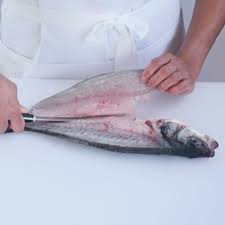Filleting a fish allows you to separate the edible flesh from the bones, resulting in boneless fillets ready for cooking. Follow these step-by-step instructions to fillet a fish properly:
Step 1: Gather Your Tools Before you begin, make sure you have the necessary tools on hand:
- A sharp fillet knife
- A clean cutting board
- A towel or paper towel
Step 2: Rinse the Fish Rinse the fish thoroughly with clean, cold water to remove any surface debris or scales. Pat the fish dry with a clean towel or paper towel.
Step 3: Lay the Fish on the Cutting Board Place the fish on the cutting board with its back facing up and its head pointing away from you.
Step 4: Make the First Incision Using the fillet knife, make a shallow incision just behind the gills and pectoral fin. Start the cut at the top of the fish and angle it towards the belly, following the contour of the dorsal fin.
Step 5: Start Filleting With the first incision made, gently insert the knife into the incision, keeping the blade against the backbone. Run the knife along the backbone, cutting down towards the tail.
Step 6: Free the Flesh As you fillet the fish, use gentle sawing motions to free the flesh from the bones. Keep the knife angled slightly downward to ensure you remove as much flesh as possible without cutting into the bones.
Step 7: Work Toward the Tail Continue filleting towards the tail, taking care to maintain a steady and controlled motion. As you approach the tail, the fillet should naturally separate from the fish.
Step 8: Repeat on the Other Side Turn the fish over and repeat the filleting process on the other side, starting with the first incision behind the gills.
Step 9: Check for Bones Once you have filleted both sides, carefully check the fillets for any remaining bones or bones fragments. Use your fingers or tweezers to remove any bones you find.
Step 10: Rinse and Pat Dry Rinse the fillets with cold water to remove any remaining scales or debris. Pat the fillets dry with a clean towel or paper towel.
Congratulations! You now have boneless fillets that are ready to be cooked and enjoyed. With practice, your filleting skills will improve, and you’ll be able to prepare delicious fish dishes with ease. Always remember to handle fish with care and dispose of the waste responsibly. Happy cooking and bon appétit!
